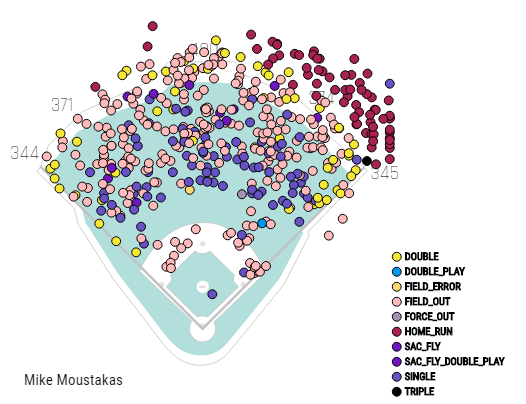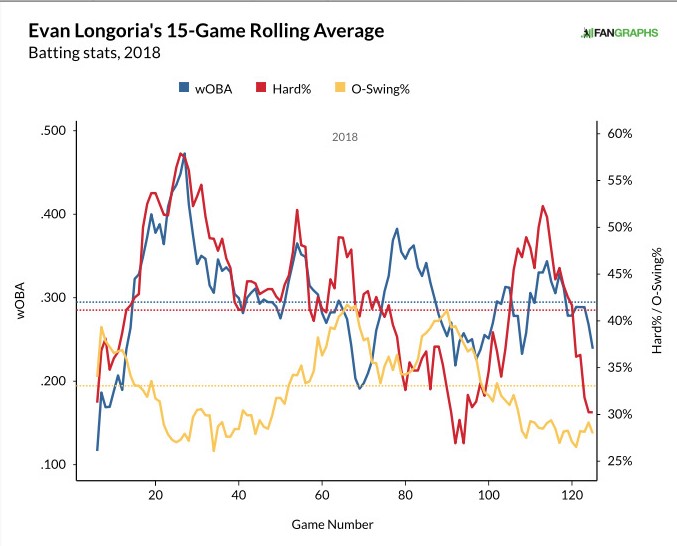Third Base is once again one of the deeper positions in fantasy baseball. Sometimes with so many talented options, players will slip through the cracks a bit and can be had at a fraction of their potential. The hot corner is littered with top-end talent including Jose Ramirez, Nolan Arenado, and Alex Bregman all with first-round ADPs in 15-team leagues. Then there are players like Anthony Rendon and Eugenio Suarez who are consistent yet unspectacular and are typically drafted at a slight discount because of it. I’ll be using the NFBC ADP data since the start of February to cover these undervalued third basemen going after the top two tiers at the position.
Travis Shaw (2B/3B – MIL) – ADP 94
Shaw absolutely loves hitting in Milwaukee. Since earning a full-time role, Shaw has put together back-to-back 30 homer campaigns. When the Brewers added Mike Moustakas in the second half of 2018, Shaw was moved over to second base and occasionally filled in at first base as well. Believe it or not, he actually sat a few games in favor of Jonathon Schoop, hurting his overall counting stats. Since then, Moustakas has re-signed with the Brewers but luckily for Shaw (and the Brewers for that matter), Schoop has signed a deal with the Twins. Early reports have Moustakas moving over to second base with Shaw staying at third. I expect there to be some deviation from the plan but position flexibility is never a bad thing, especially if you have spring training to work out the kinks. Without trying to fit three players into two spots, I’d expect Shaw to surpass 600 plate appearances for the second time in three seasons. Let’s do a quick comparison from 2018 with two similar hitters to Shaw who are both being drafted about 50 picks ahead of him.
| Player | Home Runs | K% | BB% | EV FB/LD | Barrels/BBE |
| Shaw | 32 | 18.4% | 13.3% | 93.1 mph | 10.3% |
| Player A | 34 | 22.6% | 13.2% | 94.3 mph | 11.4% |
| Player B | 25 | 23.9% | 10.9% | 95.4 mph | 8.6% |
I should specify that neither Player A nor B play the same position as Shaw but all three players have an average launch angle over 16 degrees. The Statcast metric Barrels per Batted Ball Event (BRL/BBE) is one of the best statistics to measure power. While Shaw’s average exit velocity on fly balls and line drives is lower than the other two, he’s been able to barrel balls up with regularity. What jumps out the most is Shaw’s low strikeout rate. OK, now the reveal. Player A is Rhys Hoskins who’s going 40th overall and Player B is Cody Bellinger, going 44th overall. Based on the data in the table above, it’s hard to believe Shaw is going 50 picks later, especially when you consider Shaw adding second base eligibility.
Before we jump into yet another underrated Brewer, I need to touch on Shaw’s BABIP. His career BABIP is .286 but was all the way down to .242 in 2018, completely cratering his batting average. While Shaw improved his walk and strikeout rates respectively, his poor contact increased. A fly ball rate near 45% along with an above average popup rate will suppress a hitter’s BABIP. Even still, xStats pegged Shaw for a .261 xBABIP in 2018. A .261 BABIP last year would have boosted Shaw’s average to about .257. Shaw does struggle against lefties but plays in one of the better hitting parks in all of baseball and will hit in the middle of an elite offensive lineup. Expect similar power numbers for Shaw in 2019 with about a 15 to 20 point jump in average and an increase in runs and RBI.
Matt Chapman (3B – OAK) – ADP 113
Chapman gets a ton of notoriety for his stellar defensive skills at the hot corner and rightfully so. What sometimes gets lost in his defensive talent is his power potential. Teammates Khris Davis and Matt Olson are known as the mashers in the Oakland lineup. I think Chapman has a great shot at hanging with them as the trio becomes the new Bash Brothers. Chapman’s average exit velocity was in the top two percent in all of baseball last year and more importantly ranked inside the top 20 in average exit velocity on fly balls and line drives. For reference, that’s just ahead of Paul Goldschmidt and Mike Trout. This spring, Chapman is showing that he has all-fields power with this impressive no-doubter to right field this week off of Mark Melancon. Why is this so important? Chapman hit 11 home runs to both left and center field respectively in 2018 but only one to right field. If Chapman improves his power to the opposite field, we are talking about an elite power bat.
The knock on Chapman coming up was his elevated strikeout rate as he regularly hovered around 30% in the minor leagues. In 84 games during his rookie season in 2017, he whiffed at a 28.2% clip which led to a not-so-palatable .234 batting average. Chapman made some positive strides in his first full season cutting down on swings outside the zone and most importantly, improved his contact rate on pitches in the zone. Those improvements led to a 5.5% drop in his strikeout rate to near league-average. Chapman’s patience and above-average walk rate should slot him into the second or third spot in a potent Athletics lineup. The projection systems are calling for significant regression in batting average and that’s where we differ. Chapman’s improvements at the plate make me think he’s more of a .260-.270 hitter rather than a .240-.250 hitter. In addition to the batted ball metrics discussed earlier, Chapman has a legitimate shot at 35 home runs this year.
Mike Moustakas (3B – MIL): ADP 144
This is interesting. Two Brewers, who each have averaged over 30 home runs the last two seasons, are undervalued? What a world! What surprising to me is Moustakas’ ADP has only gone up about four spots since signing with the Brewers. I still think there will be a bit of a market correction but not enough given the power potential of Moustakas for a full season in Miller Park. I’m not typically drawn to hitters with poor plate discipline and high pop up rates, but the track record and park factors of Miller Park really get me going. Moustakas actually makes contact with balls inside the zone at an extremely high rate for a slugger. He’s managed an 89.1% Z-Contact rate for his career and sat at 88.4% last year.
We did not see Moustakas take advantage of the hitter-friendly environment of Miller Park in his two-plus months with the Brewers last year. However, he did show slight improvements on his exit velocity on fly balls and line drives along with an increase in barrel rate. Moose has also appeared to figure out the best way to hit home runs is to yank them out to right field (aka pulled fly balls). He pulled over 35% of his fly balls last year which ranked 11th among hitters with at least 100 fly balls hit in 2018. That put him between Jose Ramirez and Daniel Palka, both of whom had HR/FB rates better than Moustakas. That’s where I believe he will improve. We know who Moose is at this point in terms of average (between .250-.270) but given the batted ball profile and park upgrade, we could see 35+ homers with close to 100 RBI in that lineup.

I don’t usually love this strategy, but check out the fly balls and line drives hit by Moustakas the last two seasons overlaid onto Miller Park. This is far from an exact science, but I see about 25-30 additional home runs over the last two seasons. I don’t think it’s crazy to expect an additional five to eight homers this year for Moose. Book it!
Evan Longoria (3B – SF) – ADP 398
We are not dealing with Evan Longoria the MVP candidate, but he’s literally an afterthought in 15-team leagues and going undrafted in 12-team mixed leagues. The move to San Francisco last year was a negative one in terms of power because, well, former AT&T Park (now Oracle Park) is the worst park in the league for home runs. To be fair, San Fran’s home park suppresses home runs much more for left-handed batters than right-handed hitters, so a healthy Longoria has a chance to overcome these obstacles.
The main reason behind Longoria’s power outage in the second half was a fracture to his left hand sustained when he was hit by a pitch in June of last year. Longoria hit 10 home runs with a .434 SLG in the first 2.5 months of the season prior to the injury and only six homers with a .388 SLG upon his return. Sure, he wasn’t lighting the world on fire in the first half but that’s still a full season pace of 25 home runs. Let’s turn to the rolling average graph.

The injury occurred around game 67. You can see the significant drop in hard contact after his return. There’s hope at the end of the season though! His hard contact jumped back up to 50% along with a bump in wOBA. He also was more disciplined not chasing pitches outside the zone. By all accounts, Longoria is healthy coming into 2019 and I could see him reach 20-25 home runs with a decent average and he’s basically free on draft day.
Other deep league considerations: Jake Lamb (3B – ARI) – ADP 268; Jung Ho Kang – ADP 538; Renato Nunez (3B – BAL) – ADP 589;

Brian Anderson perhaps too? He might be going undrafted in 12 team leagues, took him with my final pick in my most recent mocks.